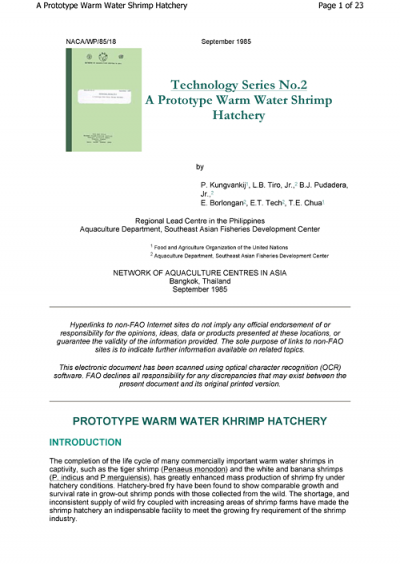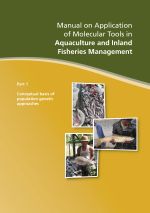A prototype warm water shrimp hatchery
15 November 2004 | P. Kungvankij, L.B. Tiro Jr., B.J. Pudadera Jr., E. Borlongan, E.T. Tech, T.E. Chua | 558 Downloads | .pdf | 788.51 KB | Hatchery and nursery, Shrimp, Environment and sustainability, Philippines
The completion of the life cycle of many commercially important warm water shrimps in captivity, such as the tiger shrimp (Penaeus monodon) and the white and banana shrimps (P. indicus and P. merguiensis), has greatly enhanced mass production of shrimp fry under hatchery conditions. Hatchery-bred fry have been found to show comparable growth and survival rate in grow-out shrimp ponds with those collected from the wild. The shortage, and inconsistent supply of wild fry coupled with increasing areas of shrimp farms have made the shrimp hatchery an indispensable facility to meet the growing fry requirement of the shrimp industry.
Although various techniques have been developed, existing techniques in shrimp seed production as a result of more than 50 years of research studies have yet to be refined, packaged and tested in different environment conditions into an appropriate technology that can be disseminated to the shrimp growers. Shrimp hatchery technology that has been established in developed nations may not be economically appropriate to developing nations. Hence, testing of any developed technology is essential to ensure its technical and economic viability in the country concerned.
A successful hatchery usually depends on a number of conditions; among the more important ones are right choice of site, effectiveness and efficiency of operational management.
In designing a shrimp hatchery, it is essential to consider the production target of a species or a number of species and the level of financial inputs. In the case of the tiger shrimps, the production target is very much limited by the supply of the spawners. This limits the production capacity of the hatchery. In the case of the white or banana shrimps for which spawners are easily available, tank capacity can be much higher. This prototype hatchery, however, was especially designed for the seed production of warm water shrimps especially the tiger shrimps, white and banana shrimps. The design of the prototype hatchery takes into consideration the technical advantages of the large and small tank hatchery systems to maximize hatchery facilities for the economic production of the target species. In essence, the prototype hatchery has the flexibility of operating at the desired level of operation dictated by the availability of spawners.
The present technology series attempts to describe the prototype warm water shrimp hatchery established and operated by SEAFDEC Aquaculture Department in collaboration with FAO since 1982. The techniques used in the operation of the hatchery have been refined, repeatedly tested and are now packaged for further testing in different environmental conditions elsewhere in the Philippines and other tropical countries.
Publisher: Network of Aquaculture Centres in Asia-Pacific
Rights: Creative Commons Attribution.

